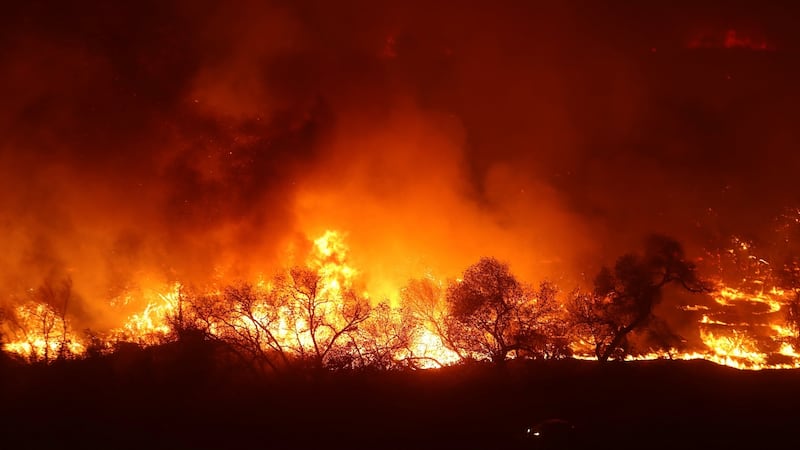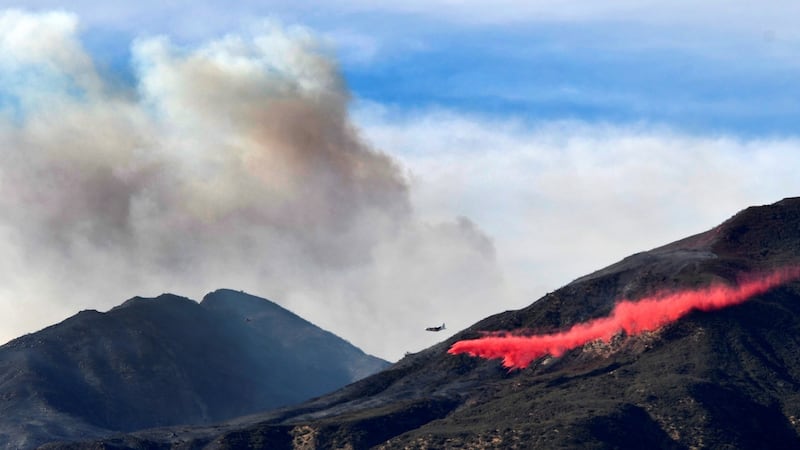Growing wildfires chewing through parts of Southern California on Friday ravaged avocado farms, racehorse stables and a retirement community, even as milder weather aided firefighters in their efforts to slow the progress of six major blazes.
Forecasters predicted weather would continue to challenge the 8,700 firefighters who have been battling fast-moving blazes for five days from the San Diego area up the Pacific Coast to Santa Barbara County. The fires killed at least one person, destroyed 500 structures, hurt six people and injured four firefighters.
At the peak, about 212,000 people were forced to flee their homes. Evacuation orders were lifted in some areas, welcome news for many in shelters waiting to see if their homes survived.
"The weather moderated today and the milder winds allowed for an increase in the number of both helicopters and air tankers that could safely complete mission dropping water and fire retardant, as well as conducting reconnaissance tasks," the Ventura County Fire Department said on its website Friday evening.
US president Donald Trump on Friday issued a federal emergency declaration for California, allowing the Federal Emergency Management Agency and Department of Homeland Security to coordinate relief efforts.

A 70-year-old woman died in a car crash on Wednesday with smoke inhalation and burns along an evacuation route in Santa Paula, the Ventura County Star newspaper reported, citing medical examiner Christopher Young.
Dangerous
Two of the most dangerous fires, in Ventura County and San Diego County, were 0 to 10 per cent contained, the CAL FIRE agency reported. Billions of dollars in property is at risk.
A joint weather forecast by firefighting agencies said temperatures would remain “well above normal for the foreseeable future.” Winds were expected to continue, peaking in strength on Sunday then becoming much lighter on Monday. “Ongoing fires may see significant growth on Sunday,” it said.
North of San Diego, the Lilac Fire swelled from 10 acres to 4,100 acres (1,659 hectares) in a few hours on Thursday, prompting Governor Jerry Brown to declare a state of emergency for San Diego County. The fire destroyed 65 structures.
Fallbrook, known for its avocado orchards, burned, and homes were destroyed in its Rancho Monserate Country Club retirement community. Blazes approached the Camp Pendleton marine base.
A 500-stall stable for thoroughbred race horses at San Luis Rey Downs training site burned late on Thursday, the Los Angeles Times reported.
An estimated 25 to 30 horses died, in addition to 29 horses killed in Los Angeles earlier in the week. A trainer suffered second- and third-degree burns over half her body trying to rescue horses, the newspaper said. She was airlifted to a San Diego hospital and placed in a medically induced coma.
Del Mar Thoroughbred Club, a racetrack in a beachside community north of San Diego, said it was providing refuge for more than 900 animals, mostly horses as well as some goats and pigs. A horse hospital was being opened on Friday.

On Twitter, animal lovers sought to reunite lost dogs with their owners and posted pleas for residents in the Los Angeles area to put out water for wild animals fleeing the fires.
Blazes
The wildfires forced producers of commercials, television shows and even student films to pause or seek alternate shooting locations. The Los Angeles Police Department on Wednesday suspended permitted filming in zones near the fires as well as other areas deemed to be at severe risk of burning. Applications for filming in the Angeles National Forest were also halted this week.
The largest of the blazes, known as the Thomas Fire, was in Ventura County, northwest of Los Angeles, and has charred 143,000 acres (57,870 hectares) and destroyed 439 structures, officials said. More than 2,600 firefighters from as far away as Portland, Oregon, and Nevada, made progress against the blaze with 10 per cent contained, up from 5 per cent on Thursday.
A huge plume of smoke flared from the fire in the Ventura County mountains on Friday and was visible on satellite images, the National Weather Service said. Astronauts have captured images showing the wildfires’ smoke visible from space, and the National Weather Service said visibility was being affected in the San Francisco area.
The Santa Ana winds, which blow hot and dry across Southern California to the Pacific, eased up on Friday, ranging from 8 km/h to 56km/h. That turned out to be a mixed blessing for firefighters because the lingering smoke limited the use of water-dropping aircraft. – Reuters









